
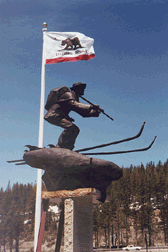
Snowshoe Thompson: "Viking of the Sierra"
When John A. Thompson responded to an ad in the Sacramento Union : "People Lost to the World; Uncle Sam Needs a Mail Carrier", he had no idea he was to become a living legend.
When I cross-country ski under the moonlight through the back country of the Sierra Nevada mountains, I often think of Snowshoe Thompson, one of the most intriguing heroes in California's history. From 1856 to 1876 he made legendary 90 mile treks over snowdrifts up to 50 feet high and through blizzards with up to 80 mile per hour winds, to deliver mail to those living in isolation. He was the sole link between California and the Atlantic states during the long winter months.
At the age of 10, Jon Torsteinson-Rue (later changed to John A. Thompson) came to America with his family from Norway, settling on a farm in Illinois. The family moved on to Missouri then Iowa, and eventually Jon went to stay with his brother in Wisconsin. Then gold fever struck.
In 1851 at the age of 24 Thompson drove a herd of milk cows to California and settled in Placerville. For a short while he mined in Kelsey Diggins, Coon Hollow and Georgetown. With the small amount he saved, he bought a small ranch at Putah Creek, in the Sacramento Valley.
All attempts by postmen to cross the Sierra on woven Canadian and Native American snowshoes had failed until one day in late 1855, Thompson saw an ad in the Sacramento Union : "People Lost to the World; Uncle Sam Needs a Mail Carrier." He had had personal experience with mail deprivation, having once received long delayed news of a flu epidemic which claimed his mother's life, and quickly applied for
the job.
As a young child in the Telemark region of Norway, ski shaped snow-shoes (called ski-skates) were as common as ordinary shoes. A crowd formed in Placerville for his first mail run in January, 1856. Few had faith that he would make it over the 7,500 foot passes on his homemade 10 foot long, 25 pound oak skis. But one optimistic voice in the crowd called out: "Good luck, Snowshoe Thompson" and he set out to become a legendary postman and father of California skiing.
Two to four times a month for twenty winters, regardless of weather, Snowshoe Thompson set out at the appointed hour. His mail run took 3 days from Placerville to Mormon Station, Utah (Nevada's first town,later called Genoa when Nevada became a state), and two days on the return trip. The people of the pioneer settlement knew when to expect his arrival. Baking was left in the oven and abandoned meals grew cold. Everyone ran outdoors looking up to the top of Genoa Peak to watch as the tall blond norseman descended, streaks of snow flying in his wake.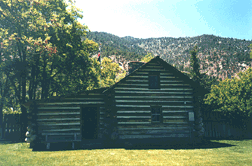
Thompson always wore a Mackinaw jacket, a wide rimmed hat, and covered his face in charcoal to prevent snow blindness. He carried no blankets, but he did carry matches to start fires, and his bible. He snacked on dried sausage, jerked beef, crackers, and biscuits. When a storm kept him from proceeding he would find a flat rock, clear it of snow, and dance old Norwegian folk dances until it passed, then he would continue on his way. He rested but briefly, and usually only long enough for a crust to form back over the fresh snow, for easier passage.
Dan de Quille of the Virigina City Territorial Enterprise later wrote of Thompson: "He flew down the mountainside. He did not ride astride his pole or drag it to one side as was the practice of other snow-shoers, but held it horizontally before him after the manner of a tightrope walker. His appearance was graceful, swaying his balance pole to one side and the other in the manner that a soaring eagle dips its wings."
Grizzly bears, mountain lions and wolves roamed his path, but he carried no gun, not wanting to limit the weight of mail and much needed supplies. On one trip he came upon a pack of wolves feeding on a deer carcass. When they noticed him, they sat on their haunches and howled. Snowshoe kept his pace, expecting them to attack at any moment, and flew right by them. When he looked back, they had returned to their meal.
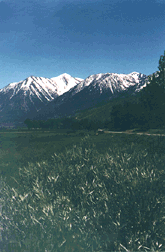 Much as his Viking ancestors had traveled upon unmarked waters, Snowshoe Thompson crossed the Sierra Mountains, whose landmarks were buried in the snow. He didn't use a compass, once stating in an interview : "There is no danger of getting lost in a narrow range of mountains like the Sierra, if a man has his wits about him." He could tell his direction by day, from the appearance of trees and rocks, the flow of the streams, animal tracks, and snowdrifts. By night, the formation of stars guided him.
Much as his Viking ancestors had traveled upon unmarked waters, Snowshoe Thompson crossed the Sierra Mountains, whose landmarks were buried in the snow. He didn't use a compass, once stating in an interview : "There is no danger of getting lost in a narrow range of mountains like the Sierra, if a man has his wits about him." He could tell his direction by day, from the appearance of trees and rocks, the flow of the streams, animal tracks, and snowdrifts. By night, the formation of stars guided him.
Snowshoe Thompson often rescued prospectors caught in the snow, and would carry them out on the back of his skis as they held their arms around him. One well-known incident took place just before Christmas in 1856, when he found a trapper named
James Sisson, who had been sheltering with half-frozen feet in a deserted cabin for 12 days, with no food or fire. Thompson chopped him some wood to stay warm and set out to Genoa for help. He had to carve skis and give lessons to the rescuers who had agreed to accompany him. Once back in Genoa, the doctor reported that Sisson's feet needed to be amputated, but he had no chloroform. Thompson set out once again to Placerville , but there was none to be found, so he continued on to Sacramento. In all he traveled 400 miles in 10 days, and saved Sisson's life.
His mail sack often weighed up to 100 pounds: carrying medicine, emergency supplies, clothing, books, tools, pots and pans. Once he brought in a pack of needles and a glass chimney for a kerosene lamp so a widow, Mrs. Franklin, could continue her winter sewing. For the local fiddler, Richard Cosser, he brought new strings. And for the news starved miners, he carried the type and newsprint for Nevada's first newspaper, the Territorial Enterprise, piece by piece. The first issue went to press December 18, 1858.
In 1859 Thompson was asked to take a strange blue rock, which seemed to be devaluing the Washoe miners' gold dust, to Sacramento to have it assayed - it was rich in silver. The Comstock Lode had now been discovered, signaling an end to the California Gold Rush and the glorious 49er era. A new stampede began, this time from west to east and Thompson was asked to expand his mail route to Virginia City, year round.
As legends of Snowshoe Thompson's feats spread through the isolated regions of the Sierra, others began making skis and racing down the hills. For a short time, during the building of the Central Pacific Railroad, he carried the mail from Cisco to Meadow Lake. During the winter of 1867-68, one of the most severe in history, 3,000 people were met with an unexpected storm and ended up wintering in at Meadow Lake City. Clarence M. Wooster wrote in a letter that Thompson would "sail down his four-mile course at great speed, cross the ice frozen river, throw our mail toward the house, and glide out of sight, up and over a hill, by the momentum gathered in the three mile descent."
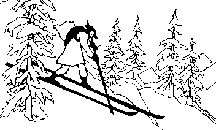 Wooster further explained in his letter how he and some kids once gave into their temptation of turning Snowshoe's frozen tracks into a sled run. They shot down the mountain like rockets: "The skis held to the track, but three of the kids went tumbling down a steep mountain." When Thompson heard of the incident he searched out the kids and gave them a spanking they never forgot!
Wooster further explained in his letter how he and some kids once gave into their temptation of turning Snowshoe's frozen tracks into a sled run. They shot down the mountain like rockets: "The skis held to the track, but three of the kids went tumbling down a steep mountain." When Thompson heard of the incident he searched out the kids and gave them a spanking they never forgot!
There are a variety of stories of how and when Thompson met his wife, the English woman, Agnes Singleton, who had come to America with her step-mother. My personal favorite is that he gave her ski lessons. They were married in 1866, however there are as many discrepancies as to the location. They settled on the property Thompson had homesteaded a few years earlier in Diamond Valley (Alpine County) - just east and at the foot of the Sierra Nevada mountains, 5 miles to the west of Carson Valley.
Deeply involved in the land and its uses, Thompson raised grains wheat, oats, hay and potatoes. As he explained in letters to his family, the only fruits he could grow
were gooseberries and currents, due to the late spring and early fall frosts. He constructed irrigation ditches, from the West Fork of the Carson River to his ranch, that are still in service today. In the winter he cared for 90 head of cattle and 20 horses - half his own, and the rest were boarded for others who lived higher up in the mountains.
The Thompson's only child, Arthur Thomas, was born on February 11, 1867. His father could hardly wait to take him snowshoeing, and made him a tiny pair of snowshoes for his first birthday. In Alpine County, Thompson enjoyed teaching his neighbors how to make snowshoes, giving them lessons and offering chilling demonstrations of his jumps at the top of Silver Mountain. Just as it seemed he was going to run into the onlookers midway down the slope, he would spring up again, flying right over them with a wide smile on his face. In one of his races, he skied 1600 feet in 21 seconds (55 miles per hour), and his greatest jump was known to be 180 feet, in the early 1870's!
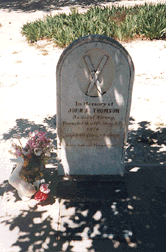 From 1868 to 1872 Thompson served on the Board of Supervisors of Alpine County,
and was a delegate to the Republican State Convention in Sacramento in 1871. In spite of a resolution sent to Washington, D.C. by the Nevada Legislature, the many political contacts he had gathered, and a trip to Washington, D.C. in 1872, Snowshoe Thompson was never paid for his services delivering the United States Mail.
From 1868 to 1872 Thompson served on the Board of Supervisors of Alpine County,
and was a delegate to the Republican State Convention in Sacramento in 1871. In spite of a resolution sent to Washington, D.C. by the Nevada Legislature, the many political contacts he had gathered, and a trip to Washington, D.C. in 1872, Snowshoe Thompson was never paid for his services delivering the United States Mail.
Snowshoe Thompson died of appendicitis which developed into pneumonia on May 15, 1876. His son, Arthur, died two years later of diphtheria, and was buried next to his father at the cemetery in Genoa. Agnes remarried in 1884, but the following year had a snow-white marble erected on Snowshoe's grave, engraved with a pair of crossed skis and the memento "Gone but not forgotten."
The Genoa postmaster S.A.Kinsey said: "Most remarkable man I ever knew, that
Snowshoe Thompson. He must be made of iron. Besides, he never thinks of himself,
but he'd give his last breath for anyone else - even a total stranger." The
few times Thompson had thought of putting an end to his legendary Snowshoe Express,
he continued just for the look on the faces of the people living in isolation.
Hundreds of thousands from all parts of the globe emigrated to California in
search of gold, but few left such a heartfelt mark on the Golden State's history
as John A. "Snowshoe" Thompson.
More about Genoa
Story and Photos by Jill Beede
Resources used for this article

HOME
PRACTICAL INFORMATION: Calendar
| Out n' About
| Business Directory
LOCAL FLAVOR: Arts
& Crafts | Flora
& Fauna | Home
& Garden | Old
Time Tahoe
FURTHER REFERENCE: Reader's
Corner | Related Links
| Visitor's Forum
ABOUT TAHOE COUNTRY:
The Webzine | Site Map
| Webmaster |
Tahoe Country / Pays de Tahoe ©1996-2007 (Jill Beede)




 Much as his Viking ancestors had traveled upon unmarked waters, Snowshoe Thompson crossed the Sierra Mountains, whose landmarks were buried in the snow. He didn't use a compass, once stating in an interview : "There is no danger of getting lost in a narrow range of mountains like the Sierra, if a man has his wits about him." He could tell his direction by day, from the appearance of trees and rocks, the flow of the streams, animal tracks, and snowdrifts. By night, the formation of stars guided him.
Much as his Viking ancestors had traveled upon unmarked waters, Snowshoe Thompson crossed the Sierra Mountains, whose landmarks were buried in the snow. He didn't use a compass, once stating in an interview : "There is no danger of getting lost in a narrow range of mountains like the Sierra, if a man has his wits about him." He could tell his direction by day, from the appearance of trees and rocks, the flow of the streams, animal tracks, and snowdrifts. By night, the formation of stars guided him.  Wooster further explained in his letter how he and some kids once gave into their temptation of turning Snowshoe's frozen tracks into a sled run. They shot down the mountain like rockets: "The skis held to the track, but three of the kids went tumbling down a steep mountain." When Thompson heard of the incident he searched out the kids and gave them a spanking they never forgot!
Wooster further explained in his letter how he and some kids once gave into their temptation of turning Snowshoe's frozen tracks into a sled run. They shot down the mountain like rockets: "The skis held to the track, but three of the kids went tumbling down a steep mountain." When Thompson heard of the incident he searched out the kids and gave them a spanking they never forgot! From 1868 to 1872 Thompson served on the Board of Supervisors of Alpine County,
and was a delegate to the Republican State Convention in Sacramento in 1871. In spite of a resolution sent to Washington, D.C. by the Nevada Legislature, the many political contacts he had gathered, and a trip to Washington, D.C. in 1872, Snowshoe Thompson was never paid for his services delivering the United States Mail.
From 1868 to 1872 Thompson served on the Board of Supervisors of Alpine County,
and was a delegate to the Republican State Convention in Sacramento in 1871. In spite of a resolution sent to Washington, D.C. by the Nevada Legislature, the many political contacts he had gathered, and a trip to Washington, D.C. in 1872, Snowshoe Thompson was never paid for his services delivering the United States Mail.